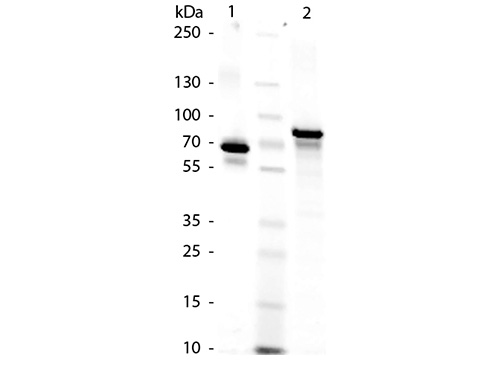HUMAN TRANSFERRIN
- SPECIFICATION
- CITATIONS
- PROTOCOLS
- BACKGROUND
| Description | HUMAN TRANSFERRIN |
|---|---|
| Conjugate | Unconjugated |
| Physical State | Lyophilized |
| Host Isotype | Transferrin |
| Buffer | None |
| Species of Origin | Human |
| Reconstitution Volume | 1.0 mL |
| Reconstitution Buffer | Restore with deionized water (or equivalent) |
| Stabilizer | None |
| Preservative | None |
| Shipping Condition | Ambient |
|---|---|
| Purity | Human transferrin was prepared from normal serum by a multi-step process which includes delipidation and selective precipitation followed by extensive dialysis. Assay by immunoelectrophoresis resulted in a single precipitin arc against anti-Human Transferrin and anti-Human Serum. |
| Storage Condition | Store vial at 4° C prior to restoration. For extended storage aliquot contents and freeze at -20° C or below. Avoid cycles of freezing and thawing. Centrifuge product if not completely clear after standing at room temperature. This product is stable for several weeks at 4° C as an undiluted liquid. Dilute only prior to immediate use. |
| Precautions Note | This product is for research use only and is not intended for therapeutic or diagnostic applications. |

Thousands of laboratories across the world have published research that depended on the performance of antibodies from Abcepta to advance their research. Check out links to articles that cite our products in major peer-reviewed journals, organized by research category.
info@abcepta.com, and receive a free "I Love Antibodies" mug.
Provided below are standard protocols that you may find useful for product applications.
Background
Human transferrin is encoded by the TF gene and is an iron-binding blood plasma glycoprotein that controls the level of free iron in biological fluids. Human transferrin binds iron very tightly but reversibly. Human transferrin is the most important iron pool in mammals. Human transferrin has a molecular weight of around 80 kDa and contains 2 specific high-affinity Fe(III) binding sites. The affinity of Human transferrin for Fe(III) is extremely high but decreases progressively with decreasing pH below neutrality.
If you have used an Abcepta product and would like to share how it has performed, please click on the "Submit Review" button and provide the requested information. Our staff will examine and post your review and contact you if needed.
If you have any additional inquiries please email technical services at tech@abcepta.com.













 Foundational characteristics of cancer include proliferation, angiogenesis, migration, evasion of apoptosis, and cellular immortality. Find key markers for these cellular processes and antibodies to detect them.
Foundational characteristics of cancer include proliferation, angiogenesis, migration, evasion of apoptosis, and cellular immortality. Find key markers for these cellular processes and antibodies to detect them. The SUMOplot™ Analysis Program predicts and scores sumoylation sites in your protein. SUMOylation is a post-translational modification involved in various cellular processes, such as nuclear-cytosolic transport, transcriptional regulation, apoptosis, protein stability, response to stress, and progression through the cell cycle.
The SUMOplot™ Analysis Program predicts and scores sumoylation sites in your protein. SUMOylation is a post-translational modification involved in various cellular processes, such as nuclear-cytosolic transport, transcriptional regulation, apoptosis, protein stability, response to stress, and progression through the cell cycle. The Autophagy Receptor Motif Plotter predicts and scores autophagy receptor binding sites in your protein. Identifying proteins connected to this pathway is critical to understanding the role of autophagy in physiological as well as pathological processes such as development, differentiation, neurodegenerative diseases, stress, infection, and cancer.
The Autophagy Receptor Motif Plotter predicts and scores autophagy receptor binding sites in your protein. Identifying proteins connected to this pathway is critical to understanding the role of autophagy in physiological as well as pathological processes such as development, differentiation, neurodegenerative diseases, stress, infection, and cancer.


